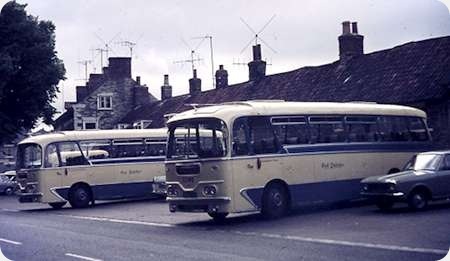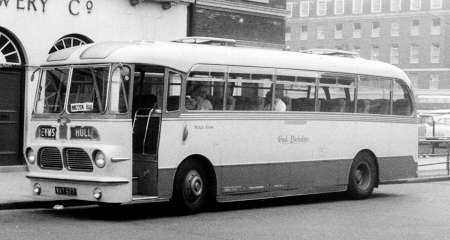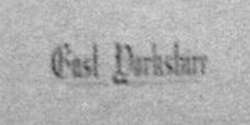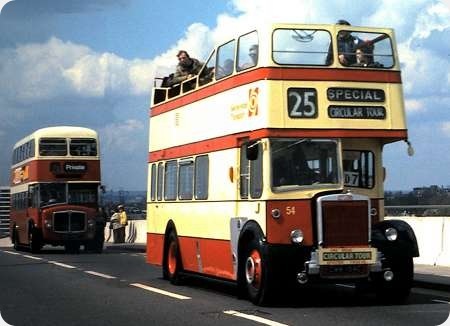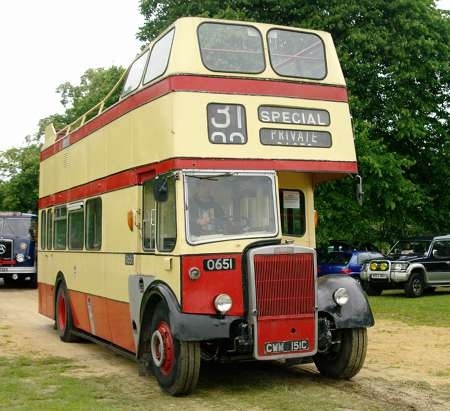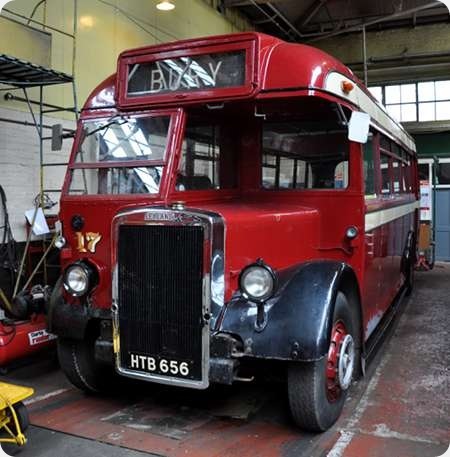East Yorkshire – Leyland Tiger Cub – 6692/3 KH – 692/3
East Yorkshire Motor Services
1960
Leyland Tiger Cub PSUC1/2
Harrington C35F
This is the pretty village of Thornton le Dale in North Yorkshire on 11th June 1968. A pair of East Yorkshire Tiger Cubs are parked up amongst the cars awaiting the return of their tour passengers. Elegant, attractive coaches enhanced by the livery and the classy gothic script fleetname.
Photograph and Copy contributed by Ian Wild
27/12/15 – 09:02
Thanks for posting, Ian. These vehicles appear to have carried names. The EFE model of 692 has her named as Pocklington Star.
Pete Davies
28/12/15 – 06:32
Pocklington Star still exists, it was bought last year by Richard Macallister of Sowerby Bridge
Don McKeown
28/12/15 – 06:34
So far as I know, nine of these East Yorkshire Leyland PSU1/2 Tiger Cub coaches were given names;
675 WAT 675 Humber Star
676 WAT 676 Dales Star
677 WAT 677 Wold Star
678 WAT 678 Buckrose Star
679 WAT 679 Hunsley Star
692 6692 KH Pocklington Star
693 6693 KH Holderness Star
694 6694 KH Driffield Star
695 6695 KH Middleton Star
Ron Mesure
29/12/15 – 09:34
East Yorkshire still name some of their coaches with these names.
Chris Hough
30/12/15 – 06:33
The Tiger Cub was PSUC not PSU. The EYMS ones were late examples of the PSUC1/2, the O:400 powered PSUC1/12 was introduced soon after.
Stephen Allcroft
30/12/15 – 06:33
Just one point of divergence. I would not myself describe the use of a difficult-to-read name style like this as classy! It was someone’s idea of classy perhaps, but firstly it is not Gothic in the strict sense- Old English may be better- and it commits the great sin of departing from a company house style. The great examples of a good-looking easy to read style- apart from the timeless LT Gill Sans- were Transport or Rail Alphabet used- and mostly still used- for road signs and railways. These did drag some of the bus industry into the 20th Century, but some were still using transfers from the year dot until NBC brought decent typography but awful colours to our buses. I am not a graphic designer but I know what I like!
Joe
30/12/15 – 13:58
The truth comes out! "Joe" is really a pseudonym for Ray Stenning! Happy New Year to one and all.
Neville Mercer
31/12/15 – 07:18
Joe, LT and TfL do not use Gill Sans type face. Since the formation of the L.P.T.B. in 1933, transport in London has used Johnston type face which had been used from 1916 by the predecessor companies.
Eric Gill, who was a student of Johnston, introduced the Gill Sans type face in 1928 and this has subtle differences from the Johnston one.
John Kaye
31/12/15 – 07:19
Oh! Joe. Cue ‘Eastenders’ drum effects! Happy New Year Neville and Joe – and of course wishing a Happy New Year to everyone else as well.
Brendan Smith
31/12/15 – 10:47
No, Neville, you have unmasked the wrong man. It was the butler. Or Colonel Mustard-and-Purple. I do not subscribe to the idea that liveries went wacko only recently- look at "streamlining" or those spats and swoops- but in the main the conservatism of the old big groups kept things very staid. I am really talking only of fleetnames, house styles and logos. The last Sheffield transport logo was very neat but for true minimalism, you need Doncaster Corporation: not only did the blinds tell you little else but the terminus it was coming from or going to- no route numbers- there was only a coat of arms with the motto "Comfort and Joy" (in Latin because it was Donny) which did not really fit the vibrating Utility AEC still doing valiant service.
Joe
01/01/16 – 07:01
I must take issue with Joe’s comment that the East Yorkshire fleetname on these vehicles "…commits the great sin of departing from a company house style."
The point here is that the company had a separate house style (or corporate identity) for the coaching part of its operations. This was not at all unusual – many of the "company" or area agreement operators used a different livery for their coaching activities. Sometimes it was just a different arrangement of the bus fleet colours (typically, a "reversed" livery), others used different colours (e.g. West Yorkshire, Eastern Counties, Crosville or Rhondda), while others also used a different style of fleetname, as East Yorkshire did – e.g. United, Western Welsh or Bristol Greyhound). Some went even further, and used a different name as well as livery for their coaching divisions, e.g. Devon General with Grey Cars or Western and Southern National with Royal Blue. The same could, of course, be said about the NBC itself. So the concept of a separate identity for the coaching business is certainly not unusual, and I certainly would not call it a "great sin". I have no doubt that the companies concerned did so for good business reasons.
As far as the font used, I would not dispute that clarity and ease of reading are important for things like destination blinds and other notices and signs. Fleetnames, however, are in a slightly different category, in that they often serve as the company logo as well, so that ease of reading is not necessarily the first priority. The NBC fleetnames were certainly bold, in some cases more so than their predecessors, but rather uninteresting as well – but I do agree that the colours were dire.
Nigel Frampton
01/01/16 – 07:01
Can not agree about a difficult to read fleet name as I think my pic of 677 on 24 August 1968 in the Coach Station demonstrates.
Malcolm Wells
03/01/16 – 16:19
In the early 1960’s, I worked as a Conductor at Colchester ENOC depot, during vacation from College. East Yorkshire’s Harrington Tiger Cub "Pocklington Star" was a regular visitor to the depot as one of their tours overnighted at The George in Colchester. The vehicle looked quite splendid among all the Green and Cream Bristols.
Russell Howard
04/01/16 – 06:25
"NBC brought in decent typography"??? The fleet name lettering on NBC buses was unimaginative, ugly and crude, well in keeping with NBC’s centralised, blunderbus approach to many aspects of the industry. The font used was a modified bold version of Futura Bk, tidied up a bit to make the letters look more evenly spaced to the eye. NBC’s Henry Ford attitude to bus liveries – any colour you like as long as it’s red or green – negated any identification benefit that the heavy fleetname might have afforded. Like the Malvina Reynolds "Little Boxes" song, they all looked just the same, but worse – even the colour distinctions were denied. Freddie Wood’s NBC trumpeted that it was "The Biggest Bus Company In The World", and bland uniformity was the name of the game. In the days preceding NBC corporatism, fleetname styles and company colours represented the identities of individual operators, just as the logos of Kelloggs or Ford or Boots, for example, have stood the identification test of decades. You don’t require to read the lettering on a Mars Bar at sixty paces to know what you are buying, any more than bus passengers of the past needed to peer myopically at the fleetname of the local double decker before boarding the thing. The decipherability of destination blinds is a different issue altogether. It is invariably advisable to ensure that one’s travel objective is shared by the driver of the bus one is travelling on.
Roger Cox
15/04/16 – 07:12
East Yorkshire Stars: Went on a tour of the Yorkshire Dales when the whole fleet of Cavaliers were present. I seem to remember that there was a 36ft version called Bridlington Star. A one-off. Do I remember rightly?
Mike
25/10/16 – 07:00
Following up Don McKeown’s note dated 28/12/15 re Pocklington Star…..does anyone know if Richard Macallister still has it and if so how I might contact him?
I drove 692 for Eddie Brown when I was nobut a lad…am now a retired nostalgic old !!!..but I would love to see 692 again.
Dave Hollings
25/10/16 – 14:05
Regarding Roger C.’s comment about destinations. I recently got on the Stagecoach service 124 from Creigiau to Cardiff. At the Radyr roundabout the driver took a left, rather than straight on to Cardiff, at which point all the passengers pointed out the mistake. The driver’s response? " Don’t worry, I normally drive the 122, so sit back and enjoy the ride. All the buses end up in Cardiff anyway." I bet that got the computerised route monitoring system thinking!
David field
25/10/16 – 16:07
Yes, David F, but if the Traffic Commissioner’s ‘monitors’ were in the area of the 124 when it followed the 122 instead, they’d record it as a failure to run. In my experience, it is not recommended for the management or staff to upset the TC!
Pete Davies
Quick links to the - Comments Page - Contact Page - Home Page
